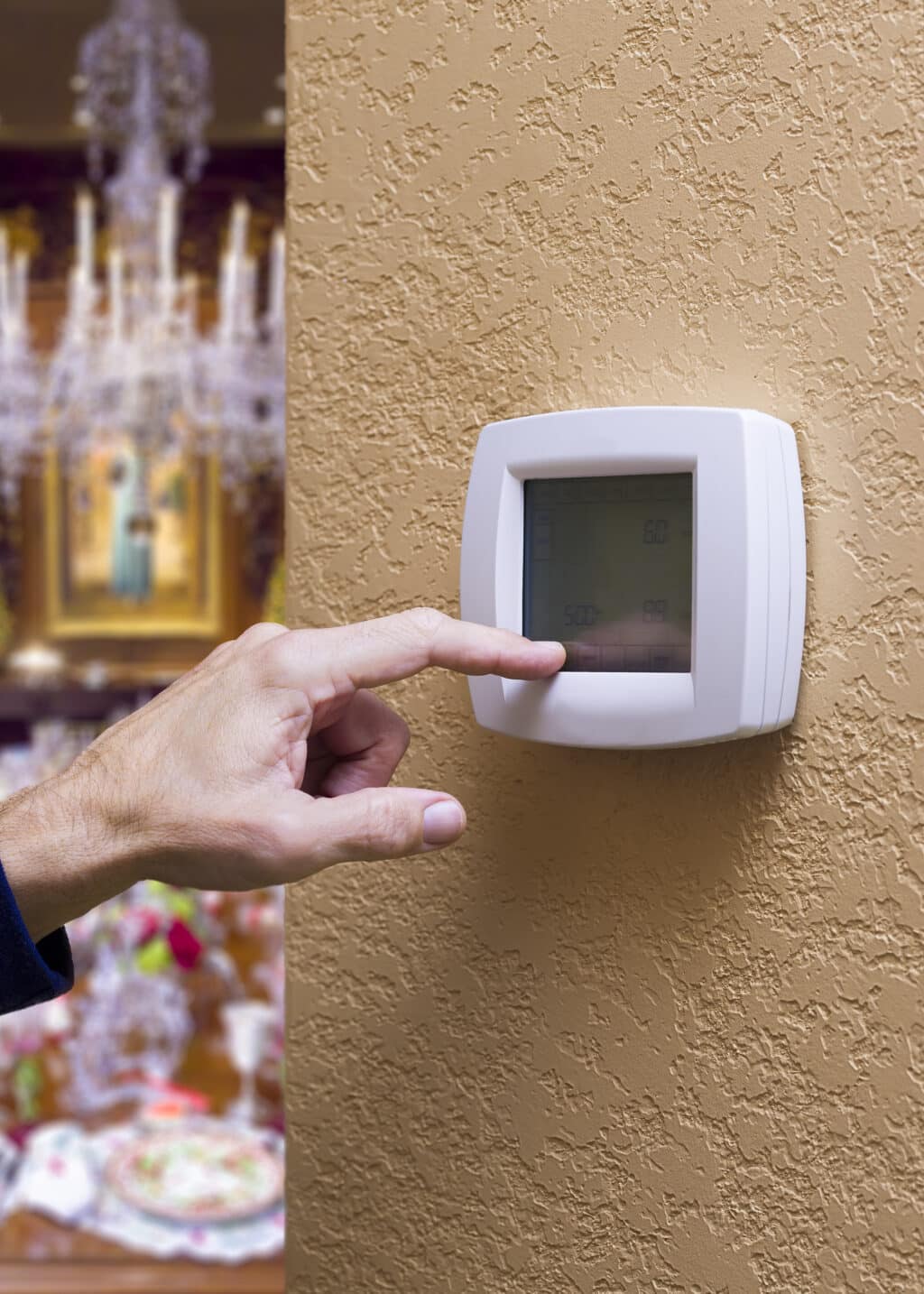
How Thermostats Impact Your Energy Bills
Thermostats help homeowners manage indoor temperatures efficiently as winter gives way to spring in Copper Canyon and Coppell, TX. More than simple controls, they directly affect energy bills by regulating heating and cooling usage. Optimizing thermostat settings prevents energy waste while keeping your home comfortable. Whether manual, programmable, or smart, each thermostat type impacts overall efficiency differently. Small adjustments now can lead to lower energy costs and improved comfort throughout the changing seasons.
Choosing the Right Thermostat for Maximum Efficiency
Selecting the right thermostat is essential for maintaining comfort and controlling energy costs in Copper Canyon and Coppell, TX. With temperatures shifting between winter’s cold and early spring warmth, having an efficient thermostat helps regulate heating and cooling effectively. The right choice depends on your household’s needs, lifestyle, and HVAC system compatibility. Below are four key factors to consider when selecting thermostats for maximum efficiency.
Understand the Different Thermostat Types
Thermostats come in three main types: manual, programmable, and smart. Manual thermostats require frequent adjustments, which can lead to inefficient heating or cooling. Programmable models allow you to set schedules, automatically adjusting temperatures based on your daily routine. Smart thermostats take efficiency further by learning your habits and adjusting settings in real-time. Choosing a model that suits your lifestyle helps reduce energy waste and lower bills.
Ensure Compatibility with Your HVAC System
Not all thermostats work with every heating and cooling system, so compatibility is crucial. Some advanced models support multi-zone systems, allowing different rooms to have personalized temperatures. Others integrate with heat pumps or dual-fuel systems, optimizing energy use year-round. Checking your HVAC system’s requirements ensures seamless operation and prevents unnecessary energy consumption.
Use Smart Features to Maximize Savings
Modern thermostats include features like Wi-Fi connectivity, geofencing, and weather tracking. These tools help adjust indoor temperatures based on outdoor conditions and occupancy. A smart thermostat can even turn off heating or cooling when no one is home, preventing wasted energy. Over time, these small adjustments contribute to noticeable energy savings.
Consider Long-Term Benefits
Investing in an advanced thermostat leads to long-term cost savings, improved home comfort, and reduced energy waste. In Copper Canyon and Coppell, where seasonal shifts impact energy use, a thermostat upgrade ensures efficient temperature management. Making the switch now helps homeowners stay comfortable while lowering monthly utility bills.

The Science Behind Thermostat Settings and Energy Savings
Thermostats directly impact energy consumption and efficiency in Copper Canyon and Coppell, TX. Understanding how temperature settings affect HVAC performance helps homeowners reduce energy costs while maintaining indoor comfort. Small adjustments in thermostat use can lead to noticeable savings throughout the year. Below are four key ways thermostats influence energy efficiency.
Set the Right Temperature for Maximum Efficiency
Keeping thermostats at recommended settings prevents energy waste:
- Winter: Set to 68°F while home and lower it when away or sleeping.
- Summer: Maintain 78°F indoors and raise it when the house is unoccupied.
- Savings: Each degree adjusted can reduce heating and cooling costs by 3%.
Avoid Frequent Temperature Adjustments
Constant thermostat changes force HVAC systems to work harder, increasing energy use. To improve efficiency:
- Keep temperatures consistent to reduce system cycling.
- Avoid extreme settings that overwork heating and cooling equipment.
- Use programmable thermostats to automate energy-efficient adjustments.
Use Smart Thermostats for Smarter Savings
Modern thermostats enhance energy efficiency with:
- Adaptive learning to optimize temperature settings based on usage.
- Geofencing to adjust settings when you are home or away.
- Weather tracking to modify temperatures based on outdoor conditions.
Enjoy Long-Term Energy Savings
Efficient thermostat use leads to:
- Lower utility bills and reduced energy waste.
- Extended HVAC system lifespan.
- Improved comfort year-round.
Making small thermostat changes today ensures long-term financial and environmental benefits.
How Smart Thermostats Learn Your Heating and Cooling Patterns
Smart thermostats are changing how homeowners in Copper Canyon and Coppell, TX, control indoor temperatures. These devices analyze your routine and adjust settings automatically to improve efficiency. By learning your habits, they create customized heating and cooling schedules that reduce energy waste while maintaining comfort. Over time, this adaptive technology helps lower utility costs and enhances HVAC system performance.
-
Tracking Temperature Adjustments
Smart thermostats monitor how often you change the temperature throughout the day. Each adjustment is recorded and used to develop a personalized schedule. Over time, the thermostat automatically adapts to your preferences, eliminating the need for constant manual changes. This process keeps your home comfortable while reducing unnecessary energy consumption.
-
Detecting Occupancy and Location
Many smart thermostats use motion sensors to detect when rooms are occupied. If a room is empty for an extended period, the system adjusts to save energy. Geofencing technology connects to your smartphone, modifying settings based on whether you are home or away. These features ensure efficient energy use without sacrificing comfort.
-
Adapting to Weather Conditions
Smart thermostats integrate with real-time weather data to optimize heating and cooling performance. If temperatures drop suddenly, the system adjusts to maintain comfort without overworking the HVAC unit. This automatic adaptation prevents energy waste and ensures efficient operation throughout the year.
By continuously learning and adjusting, smart thermostats create an energy-efficient home while keeping indoor temperatures comfortable in every season.
Common Thermostat Mistakes That Increase Energy Bills
Using thermostats incorrectly can lead to higher energy bills and unnecessary strain on HVAC systems. Many homeowners make simple mistakes that waste energy without realizing it. Avoiding these common errors helps improve efficiency, lower costs, and maintain home comfort.
Frequent Temperature Adjustments
- Constant changes force the HVAC system to work harder, increasing energy use.
- Extreme adjustments do not heat or cool a home faster; they only cause short cycling.
- Keeping consistent settings with a programmable thermostat prevents energy waste.
Inefficient Temperature Settings
- Setting thermostats too high in winter or too low in summer increases energy consumption.
- Recommended settings: 68°F in winter and 78°F in summer while at home.
- Proper settings reduce strain on HVAC systems and lower utility bills.
Poor Thermostat Placement
- Installing near windows, vents, or direct sunlight causes inaccurate readings.
- Inaccurate readings make the HVAC system run longer than necessary.
- Placement on an interior wall ensures efficient temperature control.
Ignoring Smart Features
- Many homeowners fail to use scheduling, geofencing, and energy-saving functions.
- Smart thermostats adjust based on occupancy and weather conditions.
- Activating these features improves efficiency and reduces monthly costs.
Avoiding these mistakes ensures better energy savings, extended HVAC lifespan, and consistent indoor comfort. Small adjustments make a big difference over time.
How Seasonal Temperature Shifts Affect Thermostat Usage
Changing seasons in Copper Canyon and Coppell, TX, impact indoor comfort and energy efficiency. As temperatures fluctuate, thermostats must be adjusted to maintain consistent settings while minimizing energy waste. Proper seasonal adjustments prevent HVAC strain and help lower utility costs. Understanding how different weather patterns affect thermostat usage ensures efficiency throughout the year.
-
Winter: Keeping Heat Consistent
Cold temperatures require steady heating to maintain comfort without excessive energy use. The recommended setting is 68°F when home and lower while sleeping or away. Smart thermostats automate adjustments, preventing unnecessary heating and reducing system strain. Ceiling fans running clockwise help distribute warm air more efficiently, improving indoor comfort.
-
Spring: Transitioning Between Seasons
Mild temperatures create a mix of heating and cooling needs. Opening windows for fresh air reduces HVAC usage, lowering energy consumption. Smart thermostats adjust based on real-time conditions, preventing unnecessary system cycling. Scheduling HVAC maintenance before summer ensures peak performance during hotter months.
-
Summer: Managing Cooling Efficiently
Rising temperatures increase air conditioning demand, making energy-efficient settings crucial. The ideal setting is 78°F when home and higher when away. Smart thermostats optimize cooling by adjusting based on occupancy and weather. Using ceiling fans, closing blinds, and reducing heat sources indoors further enhances efficiency.
-
Fall: Preparing for Cooler Weather
As temperatures drop, adjusting thermostats gradually helps reduce heating demand. Lowering settings slightly allows the body to adapt while conserving energy. Sealing drafts and scheduling HVAC maintenance improve performance before winter arrives. Smart thermostats anticipate seasonal shifts, ensuring comfort and efficiency.
Proper thermostat adjustments based on seasonal changes improve energy efficiency and lower utility bills, keeping homes comfortable year-round.

The Connection Between Thermostats and Indoor Air Quality
Indoor air quality affects comfort and health in Copper Canyon and Coppell, TX. While thermostats primarily regulate temperature, they also influence humidity, airflow, and pollutant levels. Proper settings help create a healthier indoor environment while maintaining energy efficiency. Understanding this connection ensures better air quality year-round.
-
Regulating Humidity for Comfort
Balanced humidity prevents mold growth and respiratory discomfort. Smart thermostats adjust heating and cooling cycles to maintain ideal levels between 30% and 50%. Some models integrate with humidifiers or dehumidifiers, preventing air from becoming too dry or damp. Controlling moisture improves both comfort and air quality.
-
Improving Air Circulation
Stagnant air traps dust, allergens, and pollutants inside the home. Thermostats with fan control settings promote even airflow, reducing stale air buildup. Running the fan periodically helps distribute filtered air, improving ventilation. Smart models automate this process for better efficiency and cleaner air.
-
Supporting HVAC Filtration
Efficient thermostat settings enhance HVAC filtration, capturing airborne particles like pollen and pet dander. Regularly replacing air filters ensures the system removes contaminants effectively. Many smart thermostats provide filter change reminders, preventing clogged filters that reduce efficiency and worsen air quality.
-
Maintaining Consistent Temperatures
Drastic temperature fluctuations affect humidity and ventilation, impacting air quality. Programmable thermostats maintain stable indoor conditions, preventing condensation and mold growth. Consistent settings reduce airborne irritants and enhance overall comfort.
Optimizing thermostat use helps improve indoor air quality while increasing HVAC efficiency. Small adjustments create a healthier, more comfortable living space.
Energy Bill Comparisons: Before and After a Thermostat Upgrade
Upgrading to modern thermostats helps reduce energy costs while improving indoor comfort. Older models lack efficiency, forcing HVAC systems to run longer and increasing utility bills. Switching to a programmable or smart model optimizes temperature control, preventing wasted energy. Comparing energy expenses before and after an upgrade highlights the financial benefits of improved efficiency.
-
Higher Costs with Outdated Thermostats
Manual adjustments on older models often lead to inconsistent temperatures and unnecessary heating or cooling. Without automation, HVAC systems run longer, increasing energy consumption. Many homeowners forget to adjust settings when leaving home, leading to higher monthly bills. Over time, inefficient thermostats contribute to excessive wear on heating and cooling equipment.
-
Lower Bills with Programmable Models
Programmable thermostats allow users to set heating and cooling schedules, preventing excess energy use. Maintaining steady settings helps HVAC systems run more efficiently, reducing costs. Studies show that properly using a programmable thermostat can cut energy expenses by 10% to 15% annually. This upgrade provides long-term savings without sacrificing comfort.
-
Smart Thermostats Maximize Savings
Smart models adjust settings automatically based on occupancy, weather, and usage patterns. Features like geofencing and adaptive learning optimize temperature control. Homeowners who install smart thermostats often see 20% or more in yearly energy savings. These advanced features enhance efficiency while reducing overall utility costs.
-
Long-Term Efficiency and Sustainability
Beyond lower bills, modern thermostats improve HVAC lifespan and reduce energy waste. Optimized temperature control prevents overuse, lowering maintenance costs. Investing in an upgraded model leads to lasting savings and better home efficiency.
Why Copper Canyon and Coppell Homeowners Should Upgrade Now
With spring approaching, now is the perfect time for homeowners to upgrade their thermostats. The mild temperatures of February make installation easier, allowing time to adjust before the summer heat arrives. Waiting until peak season can lead to increased energy costs and potential HVAC strain. Upgrading now ensures better efficiency and long-term savings.
-
Lower Energy Bills
Older thermostats often cause inefficient heating and cooling, leading to unnecessary energy waste. Smart models optimize temperature control, reducing consumption and lowering monthly utility costs by 10% to 20%.
-
Improved HVAC Performance
An outdated thermostat forces HVAC systems to work harder, increasing wear and tear. A modern upgrade helps regulate system cycles, extending equipment lifespan and preventing costly repairs.
-
Enhanced Comfort and Convenience
Smart thermostats adjust automatically based on your schedule and outdoor conditions. Features like remote access and geofencing ensure ideal temperatures without constant manual adjustments.
-
Increased Home Value
Energy-efficient upgrades appeal to buyers, making a smart thermostat a valuable addition. Investing in modern technology enhances home appeal and contributes to long-term savings.
Upgrading now guarantees better energy efficiency, lower costs, and a comfortable transition into warmer months.
The Future of Thermostat Technology and Energy Efficiency
Innovations in thermostat technology are transforming home energy management, making heating and cooling more efficient than ever. Future thermostats will integrate artificial intelligence, advanced sensors, and smart home automation to optimize energy use. These advancements will reduce energy waste, lower utility bills, and enhance indoor comfort.
-
AI-Driven Automation
Artificial intelligence will enable thermostats to learn user habits, weather patterns, and energy consumption in real time. Smart adjustments will improve efficiency without requiring manual input, reducing unnecessary heating and cooling.
-
Enhanced Sensor Technology
Advanced motion, humidity, and occupancy sensors will allow more precise temperature regulation. Thermostats will detect room usage and adjust settings automatically, preventing energy waste while maintaining ideal indoor conditions.
-
Smart Home Integration
Future thermostats will seamlessly connect with other smart devices, including lighting, blinds, and appliances. Voice control and predictive scheduling will create a fully automated, energy-efficient home.
-
Eco-Friendly Innovations
Upcoming models will feature renewable energy compatibility and real-time carbon footprint tracking. These features will support sustainable living while maximizing cost savings.
With AI, automation, and sustainability in focus, thermostat technology will continue to enhance energy efficiency and home comfort.
Upgrade Your Thermostat for Maximum Comfort and Savings
Modern thermostats provide better energy efficiency, improved comfort, and lower utility costs. Outdated models often cause HVAC systems to overwork, leading to higher bills. Upgrading to a programmable or smart thermostat helps regulate indoor temperatures more effectively, preventing energy waste while maintaining consistent comfort. Small adjustments can make a significant difference in long-term savings.
Advanced thermostat technology offers automation, remote access, and energy optimization features that improve heating and cooling performance. Smart models adjust based on your schedule, weather conditions, and occupancy, ensuring efficient operation without constant manual changes. A properly installed thermostat also extends your HVAC system’s lifespan, reducing repair costs.
At One Hour Air Conditioning & Heating of Dallas, we provide expert thermostat upgrades and professional installation services. Let our team help you find the best solution for your home. Contact us today to start saving energy while enjoying year-round comfort!
FAQs: About Thermostats
-
How do thermostats affect energy bills?
Thermostats regulate indoor temperatures, controlling how often heating and cooling systems run. Proper settings reduce energy waste and lower monthly utility costs.
-
What is the best thermostat setting for energy savings?
The recommended settings are 68°F in winter and 78°F in summer while at home. Adjusting temperatures when away helps conserve energy.
-
Do smart thermostats really save money?
Yes, smart thermostats optimize energy use by learning your habits, adjusting temperatures automatically, and reducing HVAC strain. Many homeowners save 10% to 20% annually.
-
Can frequent temperature changes increase energy costs?
Constant adjustments force HVAC systems to cycle more often, leading to higher energy consumption. Maintaining steady settings improves efficiency and prevents excess usage.
-
When should I upgrade my thermostat?
Upgrading is beneficial if you have an outdated model, rising energy bills, or inconsistent temperatures. Smart thermostats provide better efficiency and convenience.
Upgrading thermostats boosts efficiency, lowers energy bills, and enhances comfort. One Hour Air Conditioning & Heating of Dallas is here to help. Contact us today for expert service!







